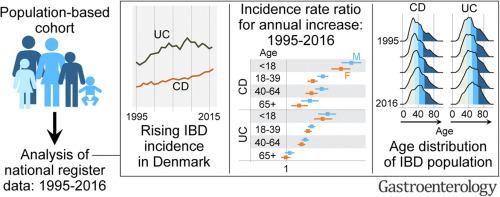Gastroenterology ( IF 29.4 ) Pub Date : 2022-08-08 , DOI: 10.1053/j.gastro.2022.07.062 Manasi Agrawal 1 , Heidi S Christensen 2 , Martin Bøgsted 2 , Jean-Frederic Colombel 3 , Tine Jess 4 , Kristine H Allin 4

|
Background & Aims
Shifts in epidemiological stages of inflammatory bowel disease (IBD) carry implications toward understanding IBD etiology and managing clinical care. We conducted a temporal analysis of the epidemiology of IBD between 1995 and 2016 in the Danish nationwide cohort.
Methods
We used the Danish registers to obtain data on demographics and IBD-related outpatient and inpatient contacts between 1995 and 2016. IBD diagnosis was defined as having ≥2 registrations related to Crohn’s disease (CD) or ulcerative colitis (UC) within a 2-year period. We estimated overall and annual incidence rates and prevalence of CD and UC standardized with respect to age and sex.
Results
A total of 47,830 individuals met the criteria for IBD diagnosis, of which 33% were diagnosed with CD and 67% with UC. Between 1995 and 2016, the incidence rate (95% confidence interval) per 100,000 person-years rose from 9.1 (8.3–10.0) to 17.8 (16.8–19.0) for CD, and from 21.0 (19.8–22.3) to 28.4 (27.0–29.8) for UC. The highest increase in CD and UC incidence rates occurred in children and young adults, respectively. The prevalence of IBD doubled from 1995 to 2016; the greatest increase (2.5-fold) was in UC prevalence among individuals aged >40 years. During this period, the median age of the IBD population increased by 6 to 7 years.
Conclusions
In Denmark, the incidence and prevalence of IBD have increased during the last 2 decades. The IBD population is shifting toward an older age. These findings have implications towards understanding environmental shifts as well as preparing health care systems for an aging IBD population.
中文翻译:

二十年来丹麦炎症性肠病负担的上升:一项全国队列研究
背景与目标
炎症性肠病 (IBD) 流行病学阶段的转变对理解 IBD 病因和管理临床护理具有重要意义。我们对 1995 年至 2016 年间丹麦全国队列中的 IBD 流行病学进行了时间分析。
方法
我们使用丹麦登记册获取 1995 年至 2016 年期间人口统计数据和 IBD 相关门诊和住院患者接触的数据。IBD 诊断定义为在 2 年内有≥2 次与克罗恩病 (CD) 或溃疡性结肠炎 (UC) 相关的登记时期。我们根据年龄和性别估计了 CD 和 UC 的总体和年度发病率和患病率。
结果
共有 47,830 人符合 IBD 诊断标准,其中 33% 被诊断为 CD,67% 被诊断为 UC。1995 年至 2016 年间,CD 的每 100,000 人年发病率(95% 置信区间)从 9.1(8.3–10.0)上升到 17.8(16.8–19.0),从 21.0(19.8–22.3)上升到 28.4(27.0– 29.8) 对于加州大学。CD 和 UC 发病率增幅最高的分别是儿童和年轻人。IBD 的患病率从 1995 年到 2016 年翻了一番;UC 患病率在 40 岁以上的人群中增幅最大(2.5 倍)。在此期间,IBD 人群的中位年龄增加了 6 至 7 岁。
结论
在丹麦,IBD 的发病率和患病率在过去 2 年中有所增加。IBD 人群正在向老龄化转变。这些发现对了解环境变化以及为老龄化 IBD 人群准备医疗保健系统具有重要意义。



























 京公网安备 11010802027423号
京公网安备 11010802027423号